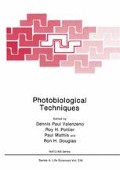Abstract
Thousands of naturally occurring and synthetic dyes can function as photosensitizers and inflict biological damage in the presence of light (Spikes, 1989 and references cited). The action is initiated by the absorption of a photon to yield an excited sensitizer and is followed by many competing dark reactions which ultimately result in the alteration of vital biomol-ecules. Reactions of the excited sensitizer can involve electron or hydrogen transfer, usually with a reducing substrate (Type I reaction) or interaction with oxygen (Type II reaction) (Foote, 1976 and references cited). The latter usually involves energy transfer to yield singlet molecular oxygen. Both Types I and Π pathways may compete, with the predominant route being determined by such factors as oxygen and substrate concentrations, the proximity of the sensitizer to the substrate as well as the nature of the sensitizers and the substrate. Both pathways ultimately lead to the formation of oxidized products and radical chain reactions resulting in extensive biological damage. Living organisms contain many enzymic and nonenzymic antioxidant mechanisms to protect against reactive oxygen species and the inability to control the latter has been defined as oxidative stress (Sies, 1986).
Access this chapter
Tax calculation will be finalised at checkout
Purchases are for personal use only
Preview
Unable to display preview. Download preview PDF.
Supplementary Reading
References
Amesz, J. (1973) The function of plastoquinone in photosynthetic electron transport. Biochem.Biophys.Acta, 301, 35–51.
Beckwith, A.L J., A.G. Davies, I.G.E. Davison, A. Maccoll and M.H. Mruzek (1989) The mechanisms of the rearrangements of allylic hydroperoxides: 5α-Hydroperoxy-3β-hydroxycholest-6-ene and 7α-hy-droperoxy-3β-hydroxy-cholest-5-ene. J. Chem. Soc. Perkin. Trans. II, 815–824.
Bernauer, Κ. and S. Fallab (1961) Phthalocyanine in wasseriger Losung I. Helv. Chim. Acta, 44, 1287–1292.
Bruce, J.M. (1967) Light-induced reactions of quinones. Quart. Rev., 21, 405–428.
Firey, P.A., T.W. Jones, G. Jori and M.A.J. Rodgers (1988) Photoexcitation of zinc phthalocyanine in mouse myeloma cells: the observation of triplet states but not of singlet oxygen. Photochem. Photobiol. 48, 357–360.
Foote, C.S. (1976) Photosensitized oxidation and singlet oxygen: Consequences in biological systems. In Free Radicals in Biology (Edited by W.A. Pryor ), Vol. II, pp. 85–133. Academic Press, New York.
Girotti, A.W. (1990) Photodynamic lipid peroxidation in biological systems. Photochem. Photobiol., 51,497– 509.
Hartley, J.A.,K.ReszkaandJ.W.Lown (1988) Photosensitization by antitumor agents. 7. Correlation between anthracenedione-photosensitized DNA damage, NADH oxidation and oxygen consumption following visible light illumination. Photochem. Photobiol., 48, 19–25.
Langlois, R., H. Ali, Ν. Brasseur, R. Wagner and J.E. van Lier (1986) Biological activities of phthalocyanines. IV. Type II sensitized photooxidation of L-tryptophan and cholesterol. Photochem. Photobiol., 44, 117–125.
Lee, P.C.C. and M.A.J. Rodgers (1987) Laser flash photokinetic studies of rose bengal sensitized photodynamic interactions of nucleotides and DNA. Photochem. Photobiol., 45, 79–86.
Schenck, G.O. (1963) Photosensitization. Ind. and Eng. Chem., 55, 40–43.
Sevanian, A. and L.L. McLeod (1987) Cholesterol autoxidation in phospholipid membrane bilayers. Lipids 22, 627–636.
Sies, H. (1986) Biochemistry of oxidative stress. Angew Chem. Int. Ed. Engl. 25, 1058–1071.
Smith, L.L. (1981) Cholesterol Autoxidation. Plenum Press, New York.
Smith, L.L. (1987) Cholesterol autoxidation 1981–1986. Chem. Phys. Lipids 44, 87–125.
Smith, L.L. and B.H. Johnson (1989) Biological activities of oxysterols. Free Rad. Biol. Med. 7, 285–332.
Spikes, J.D. (1989) Photosensitization. In The Science of Photobiology (Edited by K.C. Smith ), pp. 79–111. Plenum Press, New York.
Turro,N.J. (1978) Singlet oxygen and chemiluminescent organic reactions. In Modern Molecular Photochemistry (Edited by Ν. J. Turro) pp. 579–614. Benjamin/Cummings, London.
van Lier, J.E. (1990) Phthalocyanines as sensitizers forPDT of cancer. In Photodynamic Therapy of Neoplastic Disease (Edited by D. Kessel ), Vol. I, pp. 279–291. CRC Press, Boca Raton, FL.
Wagner, J.R., J. Cadet and G.J. Fisher (1984) Photo-oxidation of thymine sensitized by 2-methyl-l,4-naphthoquinone: Analysis of products including three novel photo-dimers. Photochem. Photobiol. 40, 589–597.
Wagner, J.R., H. Ali, R. Langlois, N. Brasseur and J.E. van Lier (1987) Biological activities of phthalocyanines. VI. Photooxidation of L-tryptophan by selectively sulfonated gallium phthalocyanines: singlet oxygen yields and effect of aggregation. Photochem. Photobiol., 45, 587–594.
Wagner, J.R., J.E. van Lier and L. J. Johnston (1990) Quinone sensitized electron transfer photooxidation of nucleic acids: chemistry of thymine and thymidine radical cations in aqueous solution. Photochem. Photobiol. 52, 333–345.
Author information
Authors and Affiliations
Editor information
Editors and Affiliations
Rights and permissions
Copyright information
© 1991 Springer Science+Business Media New York
About this chapter
Cite this chapter
Van Lier, J.E. (1991). Photosensitization: Reaction Pathways. In: Valenzeno, D.P., Pottier, R.H., Mathis, P., Douglas, R.H. (eds) Photobiological Techniques. NATO ASI Series, vol 216. Springer, Boston, MA. https://doi.org/10.1007/978-1-4615-3840-0_7
Download citation
DOI: https://doi.org/10.1007/978-1-4615-3840-0_7
Publisher Name: Springer, Boston, MA
Print ISBN: 978-0-306-43778-6
Online ISBN: 978-1-4615-3840-0
eBook Packages: Springer Book Archive

